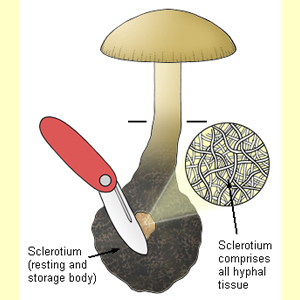
Sclerotia (and pseudosclerotia) act as a resting stage of the fungus. They are usually produced underground, and are often stimulated to produce fruit-bodies by fire.
See also pseudorhiza, where the stipe is elongated below the ground, but not expanded in diameter, and the stipe tissue in the underground portion is not significantly different in texture to that above the ground.
It may be very dense in texture, but it is possible to cut it in half. In cross section, the cut surface is usually pale in colour, and may be uniform or marbled or mottled. Microscopic examination will show only fungal elements which may be cylindrical hyphae, or can form a tissue of rounded elements (pseudoparenchyma). The outer surface of a sclerotium may be differentiated as a darker 'rind', and can be washed free of soil particles.
Once fruit-bodies have been produced, the sclerotium often shrinks and becomes irregular in shape.
A sclerotium is rarely present in agarics, occurring in Coprinopsis, Hypholoma and Pleurotus.
